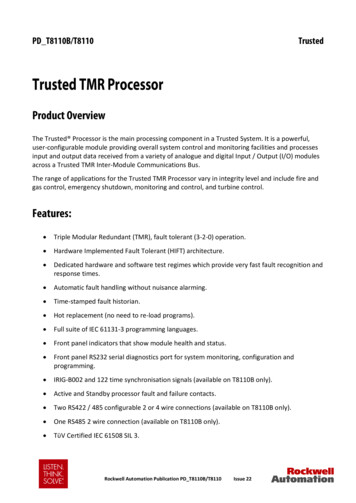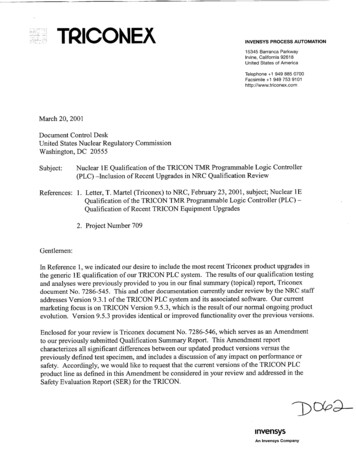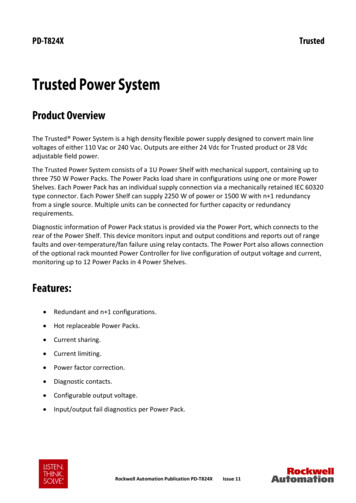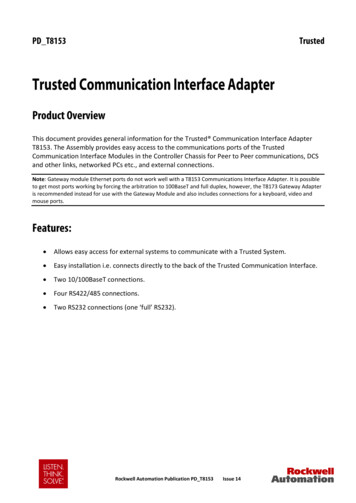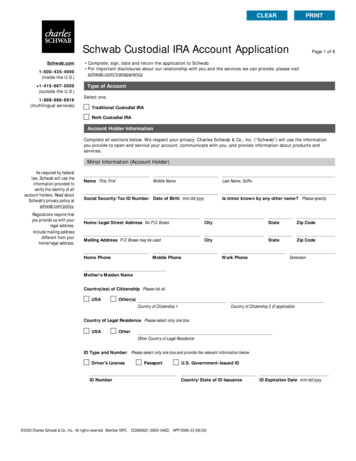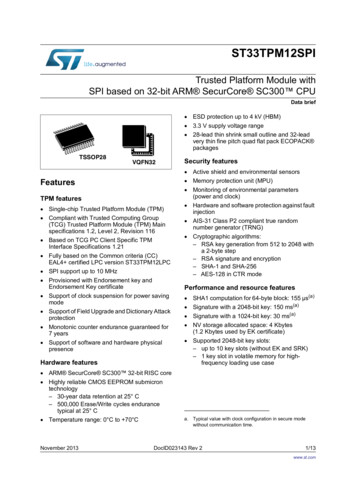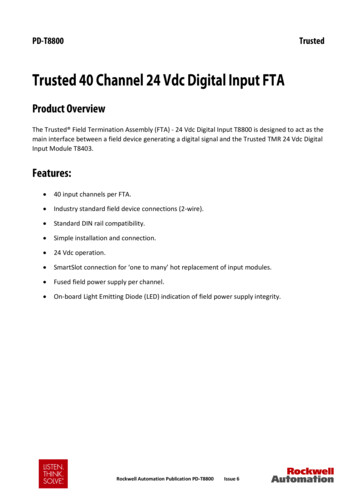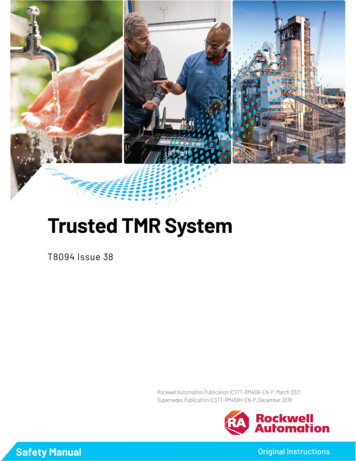
Transcription
Trusted TMR SystemT8094 Issue 38Rockwell Automation Publication ICSTT-RM459I-EN-P, March 2021Supersedes Publication ICSTT-RM459H-EN-P, December 2019Safety ManualOriginal Instructions
Trusted TMR SystemImportant User InformationRead this document and the documents listed in the additional resources section about installation, configuration, andoperation of this equipment before you install, configure, operate, or maintain this product. Users are required to familiarizethemselves with installation and wiring instructions in addition to requirements of all applicable codes, laws, and standards.Activities including installation, adjustments, putting into service, use, assembly, disassembly, and maintenance are required tobe carried out by suitably trained personnel in accordance with applicable code of practice.If this equipment is used in a manner not specified by the manufacturer, the protection provided by the equipment may beimpaired.In no event will Rockwell Automation, Inc. be responsible or liable for indirect or consequential damages resulting from the useor application of this equipment.The examples and diagrams in this manual are included solely for illustrative purposes. Because of the many variables andrequirements associated with any particular installation, Rockwell Automation, Inc. cannot assume responsibility or liability foractual use based on the examples and diagrams.No patent liability is assumed by Rockwell Automation, Inc. with respect to use of information, circuits, equipment, or softwaredescribed in this manual.Reproduction of the contents of this manual, in whole or in part, without written permission of Rockwell Automation, Inc., isprohibited.Throughout this manual, when necessary, we use notes to make you aware of safety considerations.WARNING: Identifies information about practices or circumstances that can cause an explosion in a hazardous environment, which may lead topersonal injury or death, property damage, or economic loss.ATTENTION: Identifies information about practices or circumstances that can lead to personal injury or death, property damage, or economic loss.Attentions help you identify a hazard, avoid a hazard, and recognize the consequence.IMPORTANT Identifies information that is critical for successful application and understanding of the product.Labels may also be on or inside the equipment to provide specific precautions.SHOCK HAZARD: Labels may be on or inside the equipment, for example, a drive or motor, to alert people that dangerous voltage may be present.BURN HAZARD: Labels may be on or inside the equipment, for example, a drive or motor, to alert people that surfaces may reach dangeroustemperatures.ARC FLASH HAZARD: Labels may be on or inside the equipment, for example, a motor control center, to alert people to potential Arc Flash. Arc Flash willcause severe injury or death. Wear proper Personal Protective Equipment (PPE). Follow ALL Regulatory requirements for safe work practices and forPersonal Protective Equipment (PPE).2Rockwell Automation Publication ICSTT-RM459I-EN-P, March 2021
Table of ContentsPrefaceIntroductionSafety principlesSystem recommendationsSummary of changes . 9About this publication . 9Chapter 1Purpose of safety . 13Associated documents . 14Terminology . 14Safety and functional safety . 14Safety integrity and risk class levels . 15Process Safety Time (PST) . 15Degraded operation . 16The Trusted TMR system overview . 18Chapter 2Introduction to safety principles . 21Safety management . 21Safety lifecycle . 22Scope definition . 22Functional requirements . 22Safety requirements.23System engineering .23Application programming . 24Decommissioning . 30Chapter 3Introduction to system recommendations . 33Processor performance . 33I/O architectures . 34Safety-related configurations . 34Trusted high-density I/O . 38Analog input safety accuracy. 42Energize to trip configurations . 42EN 60204 Category 0 and 1 configurations . 43NFPA 72 requirements . 44NFPA 85 requirements . 44NFPA 86 requirements.45EN 54 requirements .45Sensor configurations .47Final element configurations . 48PFD calculations . 49Processor configuration . 49Rockwell Automation Publication ICSTT-RM459I-EN-P, March 20213
Table of ContentsTiming . 50ISAGRAF Config section. 50Diagnostic access . 51Configuration file (system.ini file) configuration . 52Trusted high-density I/O module configuration . 52Module characteristics. 52SYSTEM section configuration . 53Module replacement configuration . 55Input and output forcing .56Maintenance overrides . 57Peer to Peer communications configuration . 58Triguard Peer to Peer protocol . 60Configuration . 60Application requirements and constraints (Trusted and Triguard)60Application design rules . 61Application program development . 62SIS Workstation software configuration .63Trusted Toolset Suite configuration .63Language selection. 64Process control functions .65Testing of new and previously untested functions .65Test method . 66Alternative implementation of the function block . 66Function generator . 66Main and alternative comparison Pass/Fail flag .67Test results register .67Test coverage .67Recording and filing of results.67Application development. 68Partitioning the application . 68Defensive measures . 68Testable blocks. 69Individual safety-related functions . 69Minimize logic depth . 70Communications interaction . 70Program testing . 70Cross reference checking . 71Code comparison . 72Online modification . 72Application program . 73System configuration .74Environmental requirements. 754Rockwell Automation Publication ICSTT-RM459I-EN-P, March 2021
Table of ContentsClimatic conditions . 75Electromagnetic Compatibility (EMC) . 77Physical Installation Design . 77System Power Requirements .79DC Output Module Field Power Reverse Polarity Protection . 80Electrostatic handling precautions . 80Chapter 4Example checklistsExample pre-engineering checklists . 83Example engineering checklists . 84Previously assessed functionsSystem securityRegent and Regent Plus I/OTriguardCS300Chapter 5Chapter 6Appendix AEffect of Input Architectures . 91Effect of Output Architectures. 92DX and TX Low Density module types in Safety applications .93Appendix BTriguard I/O .97Effect of input and output states .97Effect of input states.97Effect of output states . 98Safety-related inputs and outputs . 99Inputs . 99Digital inputs . 99Analog inputs . 100Fail-safe analog processing . 101Outputs .102De-energize to trip outputs.102Multiple input/output safety configuration .102Dual sensors .102Triplicated sensors. 103Dual final elements . 103Hot repair adapters. 103Appendix CMigrating a CS300 Controller. 105Overview . 105Associated documents . 106Rockwell Automation Publication ICSTT-RM459I-EN-P, March 20215
Table of ContentsSpecifications . 106TÜV Certification . 106List of modules for safety-related applications . 106Requirements for the Trusted TMR system . 107System architecture features . 109The 8162 CS300 bridge module . 110CS300 equipment power supplies . 111PI-616/PI-716 digital input board . 112PI-632/PI-732 analog input board . 112PI-626/PI-726 digital output board . 115PI-627/727 digital output board. 116TM118-TWD watchdog module . 116Site planning and installation design . 118Operational environment . 118Installation design . 118Planning the migration . 118Replicating the application . 119Prerequisites . 119Choosing application logic . 119Detecting and handling faults . 119Using the Autotest Management Function Block .120Function block library.120Hardware arrangements .120Quick reference guide . 121Choosing and using function blocks . 122General instructions . 122Testing digital inputs . 124Testing analog inputs . 125Testing digital outputs . 126Scheduling, running, and aborting tests . 127Responding to outputs from function blocks . 128Commissioning a system and repairing faults . 128Function block specifications . 128ITSTM – Input Test Manager . 129DIPT – Digital Input Point Test . 129OTSTM - Output Test Manager . 129RMET – RME Test . 130LFLT - Line Fault Line Test . 130PACK16 and UNPACK16 – Pack and Unpack 16 bits . 130Parameter Specifications . 130Connecting Fire & Gas and Emergency Shutdown Systems . 137Retaining the CD901 diagnostic panel . 1376Rockwell Automation Publication ICSTT-RM459I-EN-P, March 2021
Table of ContentsTM117-DMX Matrix Driver Interface Module . 137Making printouts of alarm and diagnostic data . 137Preparing for entry into service . 138Maintaining the migrated system . 138Maintenance schedule . 138Completion . 138Hazardous area and electricalsafety informationGlossaryRecommended proof testmethodsHistory of changesAppendix DProduct information. 139Trusted processor relay connections (applicable to T8110 only) . 139Wiring Requirements . 140Appendix EAppendix F1oo2 24V DC digital inputs . 1534-20mA analog inputs (non-isolated) . 1544-20 mA analog inputs (isolated) . 15524V DC digital outputs . 156120V AC digital outputs. 157Expansion chassis communication path . 158Appendix GRockwell Automation Publication ICSTT-RM459I-EN-P, March 20217
PrefaceSummary of changesThis manual includes new and updated information. Use these referencetables to locate changed information.Grammatical and editorial style changes are not included in this summary.Global changesThis table identifies changes that apply to all information about a subject inthe manual and the reason for the change. For example, the addition of newsupported hardware, a software design change, or additional referencematerial would result in changes to all of the topics that deal with that subject.SubjectReasonUpdated brandingMarketing product changeNew or enhanced featuresThis table contains a list of topics changed in this version, the reason for thechange, and a link to the topic that contains the changed information.About this publicationTopic nameReasonSafety management on page 21Removed recommendation for qualitymanagement system.Safety system validation on page 26Updated content.Operation and maintenance plan on page 26Added reference to EnvironmentalRequirements.Safety-related configurations on page 34Updated Note to indicate that coating is ULrecognized.Trusted high-density I/O on page 38Updated content.Climatic conditions on page 75Updated content.The Trusted Triple Modular Redundant (TMR) System has been designed andcertified for use in safety-related applications. To ensure that systems buildupon these foundations, it is necessary to impose requirements on the waysuch systems are designed, built, configured, tested, installed, andcommissioned, operated, maintained, and de-commissioned. This manualsets out the requirements to be met during these stages of a safety-relatedsystem to ensure that the safety-related objectives of a Trusted TMR Systemare achieved.This manual is intended primarily for system integrators and is not intendedto be a substitute for expertise or experience in safety-related systems. It isassumed that the reader has a thorough understanding of the intendedapplication and can translate readily between the generic terms used withinthis manual and the terminology specific to the integrator’s or project’sapplication area.Rockwell Automation Publication ICSTT-RM459I-EN-P, March 20219
PrefaceDisclaimerIt is not intended that the information in this publication covers everypossible detail about the construction, operation, or maintenance of a controlsystem installation. You should also refer to your own local (or supplied)system safety manual, installation, and operator/maintenance manuals.Revision and updating policyThis document is based on information available at the time of its publication,however, they are subject to change from time to time. The latest versions ofthe manuals are available at the Rockwell Automation Literature Library:rok.auto/literature.The latest issue of the Safety Manual is also referenced at the TÜV st product informationSee the Trusted Release Note for the revision of this document applicable tothe release at rok.auto/pcdc.For the latest information about this product, review the ProductNotifications and Technical Notes available at rok.auto/knowledgebase.Some of the Articles in the Knowledgebase require a TechConnect SupportContract. For more information, go to Knowledgebase Document ID: IP622TechConnect Support Contract - Access Level & Features.Tip: Sign in to your Rockwell Automation account to view Knowledgebase articles.Precautionary informationCAUTIONCaution notices call attention to methods and procedures that must befollowed to avoid damage to the equipment.NOTESNotes highlight procedures and contain information to assist the user in theunderstanding of the information contained in this document.10Rockwell Automation Publication ICSTT-RM459I-EN-P, March 2021
PrefaceThis symbol identifies items that must be thought about andput in place when designing and assembling a Trustedcontroller for use in a Safety Instrumented Function (SIF).WARNING:RADIO FREQUENCY INTERFERENCEMost electronic equipment is influenced by Radio Frequency Interference (RFI). Caution shouldbe exercised with regard to the use of portable communications equipment around suchequipment. Signs should be posted in the vicinity of the equipment cautioning against the use ofportable communications equipment.MAINTENANCEMaintenance must be performed only by qualified personnel. Otherwise personal injury or death,or damage to the system may be caused.CAUTION: STATIC SENSITIVE DEVICESModules in the Trusted System may contain static sensitive devices that can be damaged byincorrect handling of the module. The procedure for module removal is detailed in the relevantproduct descriptions and must be followed. All Trusted Systems must have labels fitted to theexterior surface of all cabinet doors cautioning personnel to observe anti-static precautionswhen touching modules. These precautions are detailed in Chapter 3 of these productdescriptions.AbbreviationsThis table describes the abbreviations that are used in this o2DOne-out-of-Two with diagnostics2oo2Two-out-of-Two2oo2DTwo-out-of-Two with ee with DiagnosticsDINDeutsche Industrie-Norm (German Industrial Standard)EMCElectromagnetic CompatibilityEMIElectromagnetic InterferenceESDEmergency ShutdownEUCEquipment Under ControlFBFunction BlockIECInternational Electrotechnical CommissionILInstruction ListI/OInput/OutputLDLadder DiagramMooNM-out-of-NMTSManual Test StartRockwell Automation Publication ICSTT-RM459I-EN-P, March 202111
Preface12AbbreviationDescriptionPCPersonal ComputerPSTProcess Safety TimesPSUPower Supply UnitSFCSequential Function ChartSFOCSecond Fault Occurrence TimeSILSafety Integrity LevelSTStructured TextTMRTriple Modular RedundantTÜVTechnischer Überwachungs-VereinRockwell Automation Publication ICSTT-RM459I-EN-P, March 2021
Chapter 1IntroductionIn this Section Purpose of safetyPurpose of safety13Associated documents 14Terminology 14The Trusted TMR system overview18The Trusted Triple Modular Redundant (TMR) System has been designed andcertified for use in safety-related applications. To ensure that systems buildupon these foundations, it is necessary to impose requirements on the waysuch systems are designed, built, configured, tested, installed, andcommissioned, operated, maintained, and de-commissioned. This manualsets out the requirements to be met during these stages of a safety-relatedsystem to ensure that the safety-related objectives of a Trusted TMR Systemare achieved.This manual is intended primarily for system integrators and is not intendedto be a substitute for expertise or experience in safety-related systems. It isassumed that the reader has a thorough understanding of the intendedapplication and can translate readily between the generic terms used withinthis manual and the terminology specific to the integrator’s or project’sapplication area.Safety Integrity Level (SIL) as defined in the International ElectrotechnicalCommission (IEC) standard: IEC 61508-4: 2010; Section 3.5.8 is usedthroughout industry and it is respected by the safety community.The Trusted TMR System and this manual, in its English version, have beenindependently reviewed and certified by the German certification authorityTechnischer Überwachungs-Verein (TÜV Rheinland) to meet therequirements of IEC 61508 SIL 3.The contents of this manual represent the requirements that shall be fulfilledto achieve certified safety-related systems up to Safety Integrity Level 3 (SIL 3).The conditions and configurations that shall be adhered to if the system is toremain in compliance with the requirements of SIL 3 are clearly marked.Requirements for quality systems, documentation and competence areincluded within this document. These are requirements, but are NOTreplacements for operating companies’ or integrators’ quality systems,procedures and practices. The system integrator remains responsible for theRockwell Automation Publication ICSTT-RM459I-EN-P, March 202113
Chapter 1Introductiongeneration of procedures and practices applicable to its business, and shallensure that these are in accordance with the requirements defined herein. Theapplication of such procedures and practices is also the responsibility of thesystem integrator, however, these shall be considered mandatory for systemsfor SIL 3 applications.Associated documentsThe following documents are associated with the safety requirementsapplicable to the Trusted System or provide supporting information via theTÜV Rheinland web site.Table 1-1 - Referenced documentsDocumentTitleIEC 61508Functional Safety of Programmable Electronic SystemsIEC 61511Functional safety: Safety Instrumented Systems for theprocess industry sectorEN 54-2Fire Detection and Fire Alarm SystemsNFPA 72:2012National Fire Alarm CodeNFPA 85:2015Boiler and Combustion Systems Hazards CodeNFPA 86:2015Standard for Ovens and FurnacesAn understanding of basic safety and functional safety principles and thecontent of these standards in particular are highly recommended. Theprinciples of these standards should be thoroughly understood beforegenerating procedures and practices to meet the requirements of this SafetyManual.TerminologyThe terms ‘certification’ and ‘certified’ are used widely within this Manual.Within the context of this Manual, these terms refer to the functional safetycertification of the product to IEC 61508 SIL 3. The Trusted System as aproduct is certified to a wider range of standards that are outside the scope ofthis Safety Manual.This Manual contains rules and recommendations:Rules are mandatory and must be followed if the resulting system is to be aSIL 3 compliant application. These are identified by the term ‘shall’.Recommendations are not mandatory, but if they are not followed, extrasafety precautions must be taken in order to certify the system.Recommendations are identified by it is highly recommended’.Safety and functional safetySafety: The expectation that a system will not lead to risk to human life orhealth.Safety is traditionally associated with the characteristics or hazards resultingfrom the system itself; including fire hazards, electrical safety, etc. Therequirements to be satisfied by the integrator here include wiring, protectivecovers, selection of materials, etc.14Rockwell Automation Publication ICSTT-RM459I-EN-P, March 2021
Chapter 1IntroductionFunctional Safety: The ability of a system to carry out the actions necessary toachieve or to maintain a safe state for the process and its associatedequipment.Functional safety is considered the ability of the system to perform itsrequired safety function. The requirements on the integrator here
Rockwell Automation Publication ICSTT-RM459I-EN-P, March 2021 Supersedes Publication ICSTT-RM459H-EN-P, December 2019 Safety Manual Original Instructions Trusted TMR System
